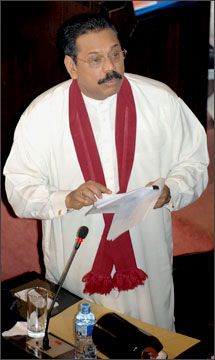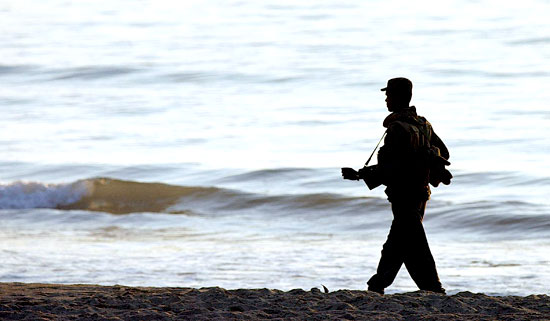Development budget to address North East shortcomings
US$ 1700 million WB and ADB aids for
development projects for the next four years
'Uthuru Wasanthaya' to bring prosperity to the
North
Salary increase for soldiers in action and
50,000 houses for war heroes proposed
Rs.500 M proposed for resettlement in North
By Dhaneshi YATAWARA
[email protected]
|

President presenting the Budget 2009
|
Amidst heavy constraints the Government will never give up the hope
for the best in the future. Along with primary responsibility of
securing the land and the people from the iron clutches of the Tigers,
the Sri Lanka Army is standing ready to provide the necessary security
to these innocent people.
The dark gloomy days are gone; gone beyond the seas. The humane
coordination between the civilians and civil and military authorities is
exemplary.
It is the wish of every leader of a country to take a fresh path
towards an undivided country, a majority consensus and a dignified
peace. As President Mahinda Rajapaksa, "I'm aware of all the
expectations of Sinhalese, Tamils, Muslims, Malays and Burghurs being
children of Mother Lanka. These expectations can be made a reality. I
possess that confidence. I will certainly fulfil that. Let us love
challenges," President Mahinda Rajapaksa concluded his Budget speech at
the Parliament last November 06 inviting all the citizens to march
together towards a better future for the country.Sri Lanka has reached a
stage where we believe, terrorism can be eliminated but forgetting the
need for a political settlement.
Initially in a post-conflict situation the early recovery is
essential. The people need quick impact projects. Rs. 25,000 million had
been spent up to now for the development in the East. Revival of the
East was made a reality under Mahinda Chinthanaya.
In mapping out the implementation strategy of the Eastern Revival,
the specific development programs have been identified as an effective
way to meet the development priorities for the respective districts. The
development takes place in the districts of Ampara, Batticaloa and
Trincomalee in an equitable manner taking into account of the population
density, territorial extent, prevalence of poverty and the status of
under-development.
The Revival Project also connects up with the national level mega
infrastructure development projects. They aim at improving the
connectivity with other regions. The Eastern revival also focuses on
livelihood development which targets expanding livelihood opportunities
and improving the living conditions of households at grass-roots levels.
These activities focus mainly on the Maga Neguma, electricity,
drinking water, irrigation and livelihood development. All these
activities are carried out under the umbrella of Gama Neguma with the
involvement of all stakeholders from the Eastern region and through the
machinery of Government agencies.
The main component of the Eastern revival includes linking and
supportive infrastructural projects which are aimed at improving
mobility and accessibility at regional level. These projects will also
improve the capacity of the regions to link up with the mainstream of
development. They have a catalytic role in boosting commercial
activities in the regions of the Eastern province.
When more areas are liberated the Government is ready to extend the
development programs. Mega projects such as the development of Colombo,
Hambantota and Oluvil Ports have been commenced. It would boost our
links with the international trade more effectively.
Steps have been taken to construct large power generation plants at
Norochcholai, Upper Kotmale and Kerawalapitiya. Water supply projects
are in progress in all main districts to enhance the availability of
drinking water. Although the required funds are in place, unfortunately
the LTTE do not permit the Government to launch the Jaffna Teaching
Hospital and the Jaffna Water Supply projects. The Government has
decided to commence the work by next year.
The World Bank and the Asian Development Bank have allocated US$ 1700
million for development projects for the next four years.
The Government has completed the construction of 100,000 houses for
those people who got displaced due to the Tsunami and has also
reconstructed the damaged fisheries harbours, roads, bridges, schools,
hospitals etc. during the past three years.
A total of Rs. 500 million is proposed in the Budget 2009 to carry
out resettlement in the North. Housing is a part of the integrated
package for the returnees. Along with it the livelihood development for
farmers, fishermen, businessmen and even small scale entrepreneurs is
also provided - both financial and technical support as required. The
main target is a sustainable livelihood development.
'Uthuru Wasanthaya'
Sri Lanka has now arrived at an important juncture. Having liberated
the East from the Tigers' grip, troops are at the final stage of
liberating Wanni and North.
While 'Neganahira Udanaya' is becoming a reality the Government is
entertaining high hopes for an 'Uthuru Wasanthaya'.
Speaking to the Sunday Observer, the Secretary to the Ministry of
Nation Building and Estate Infrastructure W. K. K. Kumarasiri said, the
Government has already taken a decision to launch 'Uthuru Wasanthaya' -
the Northern reawakening project. Apart from the existing six zones -
i.e. the country is divided into six parts for administrative purposes
by the Ministry of Nation Building - a seventh zone has been formed
which included Mannar, Vavuniya, Mullaithivu, Kilinochchi and Jaffna
districts. President Mahinda Rajapaksa proposed a total of 8000 Million
rupee allocation for the Ministry of Nation Building in the Budget 2009.
Almost all the mega development projects in terms of Mahinda
Chinthanaya are being implemented.
They are in various stages of development at present.
|

Securing the Mannar coast |
With immense gratitude to the Sri Lankan security Forces let us keep
in mind that the entire Mannar district is now under Government control.
The initial ground clearing processes are going on under the Sri Lanka
Army.
Under the Jathika Saviya program operated by the Ministry of Nation
Building and Estate Infrastructure, the necessary heavy equipment to
clear the land and level down the huge bunker lines made by excavating
the fertile soil of the 'Rice Bowl' have already been handed over to the
Army.
The MANRECAP program that commenced in 2004 with funding and
technical assistance from JICA has already been completed. In 2004 March
the MANRECAP program commenced after a memorandum of understanding
signed between the Government of Sri Lanka and JICA on Japanese
Technical Cooperation. By early 2008 the program completed its scheduled
development activities with Japanese collaboration.
In addition, the Ceylon Electricity Board is providing electricity to
many areas in Mannar under a grant by the Asian Development Bank. The
Gama Neguma and Maga Neguma programs are taking place in the area.
Under the World Bank funding worth of 300 million rupees, the gem of
the Rice Bowl - the Giants' Tank - will be reconstructed along with the
main irrigation canals of the system.
The coastal line connecting the land and the Mannar island is being
replaced by a state of the art bridge with financial and technical
assistance from JICA.
In Jaffna 120 villages covering an area of 14,943,048.3 square meters
of land have been cleared of mines so far, the Situation report issued
by the Jaffna GA said.
The Ministry of Nation Building awaits the security clearance from
the Sri Lanka Army to commence building infrastructure facilities,
establishing local administration and further development in its
recently liberated areas of Mannar.
The A 32 road from Mannar to Pooneryn is being reconstructed jointly
by the Sri Lanka Army and the Sri Lanka Navy. It will no doubt, provide
a true lifeline to Government operations.
Government's commitment to totally eradicate terrorism remains
unchanged. LTTE cadres who surrender to the Government are given the
full support to rehabilitate themselves and return to their normal
lives. To make this process more effective and wider the President
proposes Rs. 3,000 million to rehabilitate LTTE cadres which we hope
will be accepted by the Parliament in view of the momentum it gathered.
Amidst all this chaos the Government has not given up hope.
The key policy objective of the Government is to develop all villages
in the country so that they emerge as micro centres of growth on modern
lines. The village should be able to retain its decent and comfortable
nature for people to live, work and engage in their cultural and
communal activities. Remember, for a long time we were a nation of
village communities.
The larger majority of the population lives in the rural areas.
If is to be successful, any development initiative should give due
recognition to this reality.
Though many, especially some of those alien elements who do not have
an iota of an idea about the nature of our country continue to criticize
and thunder allegations against the commitment of the officials.
The Government is not treating every Tamil civilian as a Tiger though
the LTTE treats every Sri Lankan as its enemy. A cursed thought - seeing
their own brethren as the enemy!
While several INGOs are truly supporting the development of the
country some others, knowingly or unknowingly have supported the
terrorist organization in many ways.
A high Government official in constant coordination with INGOs, who
did not want to disclose himself, told the writer that one of the INGOs
confirmed that it had lost a number of good vehicles in the uncleared
areas - they do not know there present whereabouts.
Several INGOs engaged in development activities said they only
conduct small scale development activities like repairing and
reconstructing rural roads, rebuilding culverts, building community
halls etc.
An international NGO with its massive financial and technical
background has a greater scope for providing a greater boost to the
communities. In these uncleared areas how can one expect the NGO workers
to carry on their work independently, when the terrorists are getting
more and more frustrated with the defeats and setbacks they face
everyday.
With gratitude
We are indebted to our soldiers and their families for their
sacrifices and we should constantly admire them, President Rajapaksa
highlighted in his 2009 budget speech. Therefore, the President proposed
a salary increase for soldiers engaged in action from Rs. 3,000 to Rs.
5,000. A total allocation of Rs. 4,500 million is required to meet this
commitment.
A total of 50,000 houses for our war heroes will be built under the 'Mahinda
Chinthanaya' of which 1,500 are already constructed during phase I, with
water, electricity, telephones, banks, market places, schools and
hospital facilities.
When the people are strengthened, especially in terms of economy and
socially, it affects the country's stability very encouragingly. |
